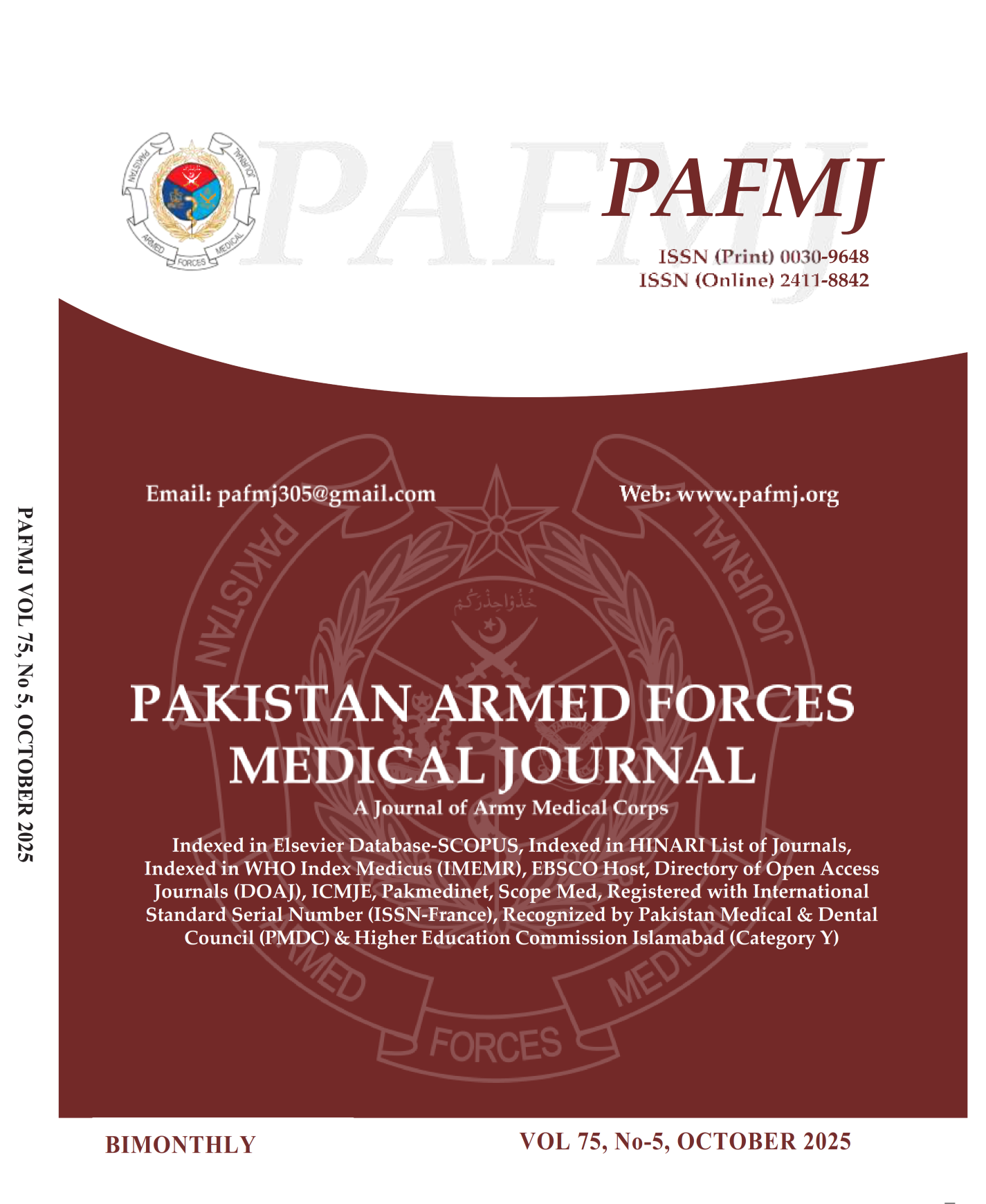A Comparative Study Between Fentanyl and Lignocaine on Attenuation of Hemodynamic Response to Laryngoscopy and Intubation in Cardiac Patients
DOI:
https://doi.org/10.51253/pafmj.v75i5.10936Keywords:
Hemodynamics; Intubation, Intratracheal; Fentanyl; Lidocaine.Abstract
Objective: To evaluate and compare the efficacy of intravenous low-dose fentanyl versus lignocaine in mitigating the occurrence of hemodynamic response during endotracheal intubation.
Study Design: Quasi –experimental study.
Place and Duration of Study: Pak Emirates Military Hospital, Rawalpindi, Pakistan, from Feb to Jul 2023.
Methodology: The study included 82 patients, aged between 30 and 65 years, undergoing elective non-cardiac surgery requiring general anesthesia and randomized them into two groups to compare the effects of intravenous Lignocaine (Group L) and Fentanyl (Group F) before laryngoscopy, on patients with moderate lower ventricular dysfunction (left ventricular ejection fraction between 35- 45%). All patients had mean arterial pressure (MAP) and pulse rate recorded during laryngoscopy and intubation.
Results: The baseline pulse rate in Group F was 73.76±4.90 beats per minute, increasing to 84.53±6.32 during laryngoscopy and intubation while baseline MAP was 91.85±1.93 mm of Hg which increased to 95.55±4.09 mm. However, in Group L, the heart rate escalated substantially upon laryngoscopy and intubation and increased to 91.78±1.84 beats per minute from baseline heart rate of 72.85±4.95 beats per minute, while MAP during laryngoscopy and intubation increased to 106.57±4.401 mm of Hg from 91.78±1.84mm of Hg (p-value <0.001) indicating that fentanyl caused lesser pressor response than lignocaine
Conclusion: Fentanyl was noted to be superior to lignocaine for mitigating stress response in cardiac patients during laryngoscopy and intubation.
Downloads
References
1. Mulimani SM, Talikoti DG, Vastrad VV, Sorganvi VM. Efficacy of a bolus dose of esmolol and bolus dose of lignocaine for attenuating the pressor response to laryngoscopy and endotracheal intubation in general anesthesia: A comparative study. Anesth Essays Res 2019; 13(2): 292–296.
https://doi.org/10.4103/aer.AER_126_18
2. Khanday SB, Mir AH, Sofi KP, Lone AQ, Shah AN. Evaluation and comparison of fentanyl versus nalbuphine for attenuation of hemodynamic response to laryngoscopy and endotracheal intubation in general anesthesia. Anesth Essays Res 2019; 13(1): 111–116. https://doi.org/10.4103/aer.AER_188_18
3. Bakeer AH, Abdallah NM. Attenuation of the hemodynamic response to tracheal intubation with gabapentin and oral midazolam. Anaesth Pain Intensive Care 2019; 23(1): 82–87.
4. Sachidananda R, Umesh G. A review of hemodynamic response to the use of different types of laryngoscopes. Anaesth Pain Intensive Care 2019; 13(4): 201–208.
5. Jothikumar L. Comparative evaluation of administration of dexmedetomidine and fentanyl for stress attenuation during laryngoscopy and endotracheal intubation [doctoral dissertation]. Tiruchirappalli: KAP Viswanatham Government Medical College.
6. Ramos-Matos CF, Bistas KG, Lopez-Ojeda W. Fentanyl. In: StatPearls [Internet]. Treasure Island: StatPearls Publishing; 2023, updated continuously.
7. Chirinos JA, Zamani P. The nitrate-nitrite-NO pathway and its implications for heart failure and preserved ejection fraction. Curr Heart Fail Rep 2016; 13: 47–59.
https://doi.org/10.1007/s11897-016-0277-9
8. Tan K, Harazim M, Tang B, McLean A, Nalos M. The association between premorbid beta blocker exposure and mortality in sepsis — a systematic review. Crit Care 2019; 23: 1–2. https://doi.org/10.1186/s13054-019-2520-5
9. Thippeswamy RR, Shetty SR. Intravenous low dose fentanyl versus lignocaine in attenuating the hemodynamic responses during endotracheal intubation: A randomized double-blind study. Anesth Essays Res 2018; 12(4): 778–785. https://doi.org/10.1186/s13054-019-2520-5
10. Sharma R, Singh S, Taank P. Comparison of lignocaine and fentanyl for attenuation of cardiovascular response during laryngoscopy and tracheal intubation in cardiac surgery patients. Int J Biomed Res 2018; 9(10): 342–345. https://doi.org/10.7439/ijbr.v9i10.4919
11. Splinter WM, Cervenko F. Haemodynamic responses to laryngoscopy and tracheal intubation in geriatric patients: effects of fentanyl, lidocaine and thiopentone. Can J Anaesth 1989; 36: 370–376.
https://doi.org/10.1007/BF03005332
12. Hassani V, Movassaghi G, Goodarzi V, Safari S. Comparison of fentanyl and fentanyl plus lidocaine on attenuation of hemodynamic responses to tracheal intubation in controlled hypertensive patients undergoing general anesthesia. Anesth Pain Med 2013; 2(3): 115–118.
https://doi.org/10.5812/aapm.6442
13. Gurulingappa, Aleem MA, Awati MN, Adarsh S. Attenuation of cardiovascular responses to direct laryngoscopy and intubation — a comparative study between IV bolus fentanyl, lignocaine and placebo (NS). J Clin Diagn Res 2012; 6(10): 1749–1752.
https://doi.org/10.7860/JCDR/2012/4070.2619
14. Dang TN, Hoai NT, Viet SN, Le Huu T, Van KT, Manh CN, et al. Acute myocardial infarction in a patient without cardiac risk factors during emergence from general anesthesia: a case report. JA Clin Rep 2020; 6(1): 48.
https://doi.org/10.1186/s40981-020-00353-4
15. Hashemian AM, Doloo HZ, Saadatfar M, Moallem R, Moradifar M, Faramarzi R, et al. Effects of intravenous administration of fentanyl and lidocaine on hemodynamic responses following endotracheal intubation. Am J Emerg Med 2018; 36(2): 197–201.
https://doi.org/10.1016/j.ajem.2017.08.052
16. Gold MR, William GD, Diane CS, Taylor BT. Esmolol and ventilatory function in cardiac patients with COPD. Chest 1991; 100(5): 1215–1218.
17. Amer I. Fentanyl versus dexmedetomidine as an adjuvant to propofol for fiberoptic intubation in patients with temporomandibular joint ankylosis. EJENTAS 2022; 23(23): 1–7. https://doi.org/10.21608/ejentas.2021.64169.1320
18. Verschoor-Kirss M, Rozanski E, Rush JE. Use of esmolol for control of tachycardia in 28 dogs and cats (2003-2020). J Vet Emerg Crit Care 2022; 32(2): 243–248.
Downloads
Published
Issue
Section
License
Copyright (c) 2025 Namra Khan, Abid Khan, Usman Eijaz Malik, Ali Mazhar Rizvi, Najm us Saqib, Khalid Ameer

This work is licensed under a Creative Commons Attribution-NonCommercial 4.0 International License.















